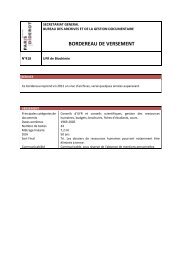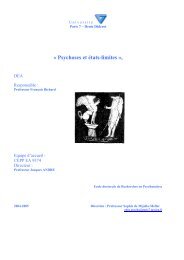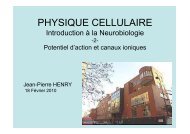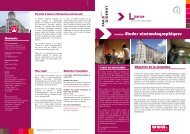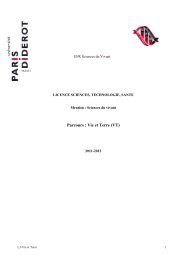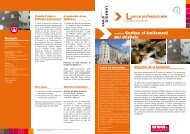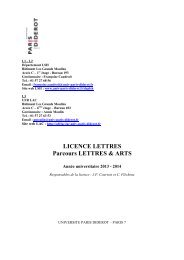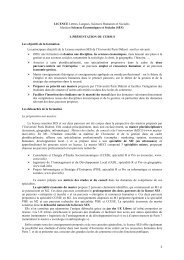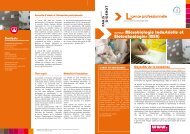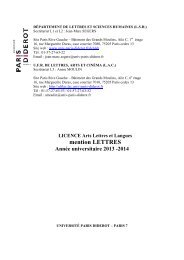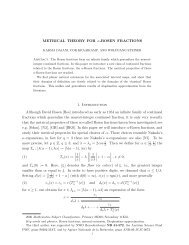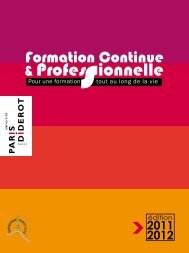Coordinator's names Carole DELPORTE-GALLET Hugues ...
Coordinator's names Carole DELPORTE-GALLET Hugues ...
Coordinator's names Carole DELPORTE-GALLET Hugues ...
Create successful ePaper yourself
Turn your PDF publications into a flip-book with our unique Google optimized e-Paper software.
do so. This often leads to add some game theoretic model to the system, specifying the utilities of involved<br />
agents, and then revisiting whether situations computed globally correspond to equilibria in the sense of<br />
game theory.<br />
Objectives of the task:<br />
Sub-Task 6.1: Reducing the time complexity of distributed algorithms using quantum effects. The starting<br />
point for our considerations is the well-established LOCAL model of distributed computing with a<br />
network graph of processors exchanging messages of unbounded size. In this context, we wish to discover<br />
how the introduction of a globally pre-entangled state of the system or the application of quantum<br />
communication channels can decrease the number of rounds required to solve classical combinatorial<br />
optimization problems, such as graph (∆ + 1)-coloring. Currently, only some very simple proof-ofconcept<br />
examples of such problems are known [21]. We are especially interested in effects which<br />
require quantum entanglement and cannot be obtained using purely classical correlations, such as<br />
shared random bits.<br />
Sub-Task 6.2: Providing a comparison of the “computational power” of the quantum and non-quantum<br />
models, formalising the notion of locality in quantum distributed computing, and showing how it<br />
essentially differs from the understanding of locality in the LOCAL model. In particular, we would<br />
like to obtain more precise algorithmic characterizations of probability distributions of feasible outputs<br />
which can be obtained by a quantum system in a given number of rounds. We also intend to elaborate<br />
lower bounds on the complexity of problems in quantum models by making use of more powerful models<br />
of computations based on stronger-than-quantum non-local boxes (Popescu-Rohrlich boxes and their<br />
variants), which we intend to define for the purpose.<br />
Sub-Task 6.3: Identifying the potential of quantum information in topological queries. We would like to<br />
study the potential of quantum information in reducing the size of distributed data structures required<br />
for tasks such as adjacency labeling or distance labeling of a graph, allowing the recovery of information<br />
about the location of a pair (or more generally subset) of nodes of a graph based only on the information<br />
stored within these nodes. In this sense, we would like to establish if information “spread out” over the<br />
whole graph using entangled states can prove more efficient in local queries than classical information<br />
(without globally violating the information bound implied by Holevo’s theorem).<br />
Sub-Task 6.3: Providing a comparison of the “computational power” of models when rationality is imposed<br />
and when it is not, formalising when local rules in distributed computing correspond to rational rules<br />
in the sense of game theory, and showing how it may or may not influence the computational power<br />
of the involved models. In particular, we would like to understand how complexity classes proposed<br />
in the other tasks differ or not from their analog when the hypothesis of rationaly is imposed to<br />
agents. This involves to consider the various possibilities to go from a game to a distributed system<br />
(ex. by repeating local games, by evolutionay game theory models) and then characterize what can be<br />
computed by which model using the corresponding notion of rationality.<br />
3.3 Tasks schedule, deliverables and milestones<br />
All the tasks listed in the previous sections are in symbiosis, and there is no precedence constraints among<br />
them. Each of the tasks is related to a well identified problem, and the resolution of any problem will benefit<br />
to many others. In fact, the tasks are as many different ways of tackling key fundamental problems in the<br />
framework of distributed computing. Moreover, because of the theoretical research flavor of the tasks, it is<br />
quite hard (and probably inappropriate) to decide when a task should start and end.<br />
On the other hand, DISPLEXITY will pay attention to allow the participants to the project to be<br />
cross fertilized by the results of all its members. This will be implemented via frequent meetings and visits<br />
between the three sites. By doing so, the participants to DISPLEXITY will share a common expertise, and<br />
be able to solve more and more complex problems related to the tasks of the project. Within the 4-years<br />
14



